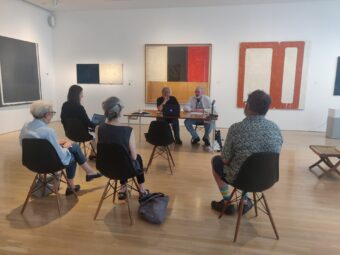Written by CIMA’s Spring 2021 Intern, Clara Apostolatos.
On the east wing of our gallery space hangs a suite of 17 drawings made by Frank O’Hara and Mario Schifano, the Italian artist at the center of our current exhibit “Facing America: Mario Schifano, 1960-65”. The series was realized in the spring of 1964, brought back to Italy by Schifano himself, and was first exhibited later that year in Rome. It entered a private collection and was mostly unknown in the United States until sold at auction five years ago. This is the first time that the works on paper have been exhibited in the United States and given its peculiarity and singularity, it has amassed great interest from our visitors.
Inspired by Schifano and O’Hara’s “Words and Drawings”, CIMA fellow Virginia Magnaghi, PhD candidate at the Scuola Normale Superiore Pisa, organized a series of talks led by a diverse group of poets, writers and scholars. Titled “Framing Words and Drawings,” this program was created with the goal of contextualizing the series within the coeval collaborations between Frank O’Hara and artists such as Larry Rivers, Grace Hartigan, Jasper Johns, Joe Brainard, Norman Bluhm, and Alfred Leslie, as well as the broader poet-painter creative partnerships of the 1960s and ’70s. Virginia conceived and curated this series of talks with the aim of generating conversation surrounding the historical and cultural context in which the works on paper were created, while expanding our understanding of the cultural milieu which Schifano interacted with when he came to New York in 1964.
Commenting on the origin of this program of forums, Virginia shared, “When I arrived at CIMA I soon realized that this series was the most outstanding piece in the exhibition in terms of being unknown, for sure, and being unexpected. Because it is something that Schifano did not do before or after that, collaboration is something that O’Hara brought Schifano into. So clearly this is an important part of the exhibition where research was needed.” She is particularly grateful to poet and writer John Yau, who wrote a wonderful exhibit review in the spring of 2021 that stressed this collaboration, and suggested that Virginia connect with other scholars of poet-artist collaborations, which eventually led to her organizing this series of talks.
Virginia opened the series of talks by saying, “As you will notice, collaboration is not only a matter of the collaboration of Schifano and O’Hara in 1964, it’s actually what happens between us today. The idea was that by collaborating all together from different backgrounds, we can arrive at a better framing of this series of very particular suite of seventeen drawings and to enjoy framing this work in its context.” This event encapsulates the spirit of CIMA, to bring together people of different scholarly, humanistic, and artistic fields and practices in joint conversation on Italian modern art.
The first programmed event centered on transatlantic creative investments and exchanges between artists, poets and writers from the United States and Europe. While Dr. Matthew Holman centered his talks on O’Hara’s collaborations with European artists, Yale University Professor Karin Roffman analyzed the transcultural circles of Mario Schifano and John Ashbery.
The next pair of talks considered more closely the synergistic interaction of word and image. American poet and Bard College Professor Ann Lauterbach compared the simultaneous forms of signage in this unique pairing of calligraphic writing with figurative elements. Université Gustave Eiffel’s Dr. Oliver Brossard complicated and expanded our understanding of poet-artist collaboration: by drawing out the tension between the dueling modalities of text and drawing, he demystified the idea of collaboration as a wholly harmonious process.
For our third event, poets Tony Towle and John Yau delivered their talks at our gallery space in front of CIMA staff and members. Towle, who was a student and close friend to O’Hara, spoke of the several poet-artist collaborations he witnessed as a young writer. Despite being a member of O’Hara’s social and artistic circles, Towle does not recollect the Schifano-O’Hara collaboration ever being spoken of. He commented, “The more I think about it, that’s the closest, most intimate collaboration O’Hara ever did,” because it remained largely private, personal and undisclosed to others. Writer and critic John Yau then presented on O’Hara’s collaboration with Norman Bluhm titled “Poem-Paintings, sharing many colorful anecdotes on the close relationship between the artist and painter as well as the creative interactions that led to the production of this text-image integrated work.
For the fourth and final meeting we welcomed once again Dr. Roffman to join poet Ron Padgett for a conversation on the New York School collaborations, anchored by a detailed account of notable poet-artist projects of the ‘60s and Padgett’s observations as a participant of this cross-disciplinary cultural phenomenon. Padgett walked us through the rise of poet-artist interactions, referencing artist Joe Brainard’s collaborations with Frank O’Hara, Ted Brainer and Padgett himself.
Following the conclusion of the series, Virginia shared that a memorable moment was having Towle and Yau present their talks in-person at CIMA, surrounded by Schifano’s art—a group of paintings and drawings that emerged from and was deeply influenced by the social circles, creative influences, and cultural happenings that surrounded Schifano during his time in New York. As one of the first in-person events CIMA has hosted in over a year, we were thrilled to be able to host an intimate gathering and conversation surrounding the themes of this speaker series and how they relate to the “Facing America” exhibit.
Despite the limitations posed by quarantine restrictions, Virginia is grateful that the entire series was zoom-mediated as it allowed her to invite scholars from Europe who, without this digital platform, would not have been able to present their rich essays.



